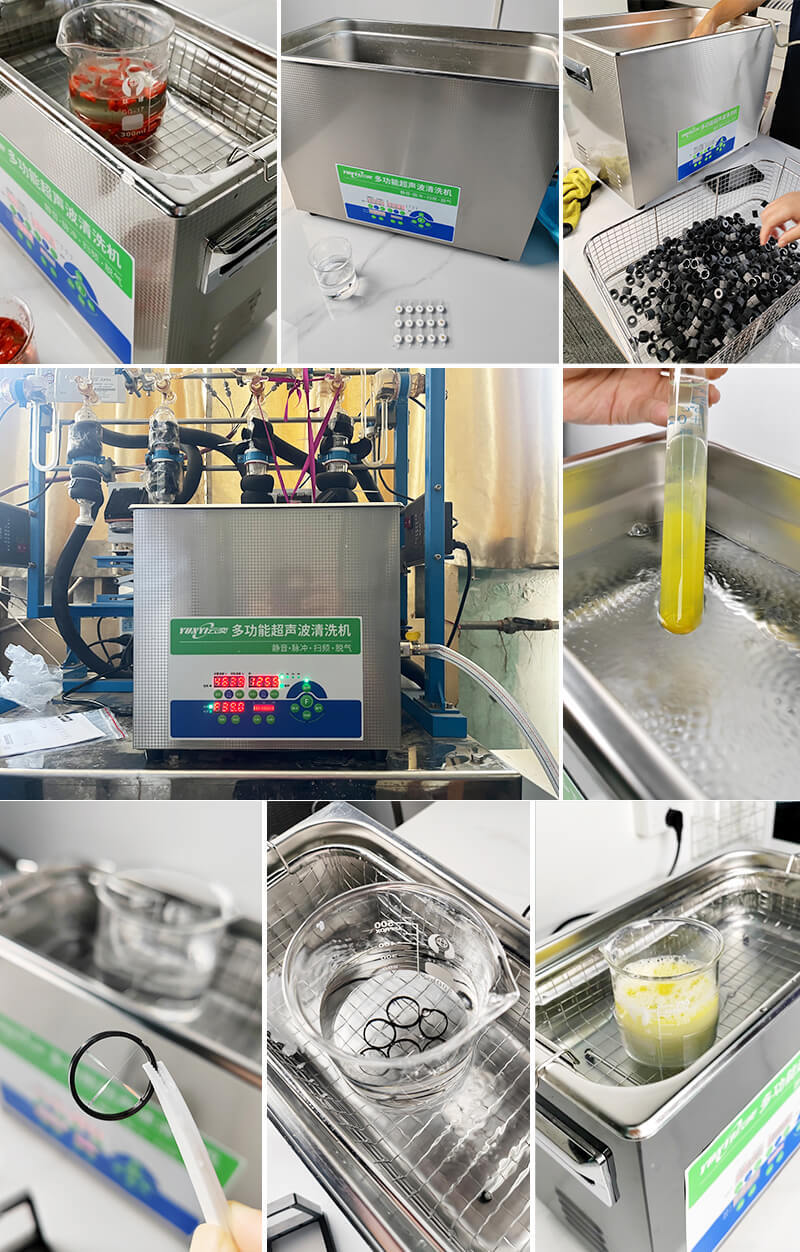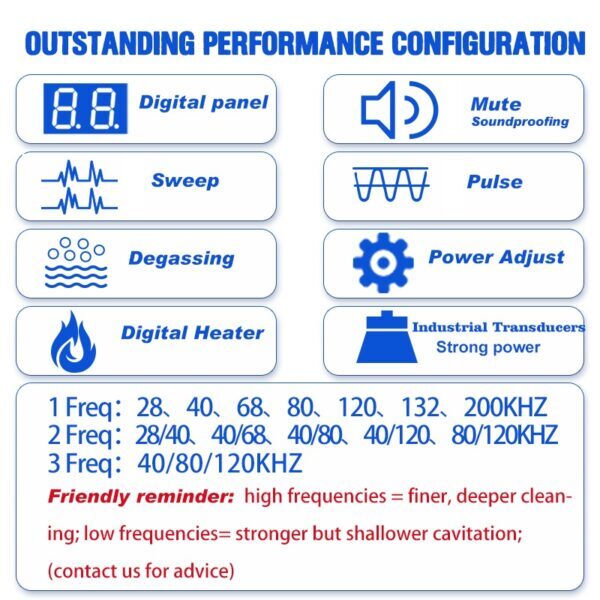If you’ve ever gone hunting for an ultrasonic cleaner—whether online, in-store, or through a supplier—you’ve probably faced this: page after page of devices that all look the same. Hundreds of brands, a dizzying range of features, flashy terms like “digital cavitation” or “turbulent scrubbing,” and prices that seem to have no rhyme or reason. So where do you start?
It’s not just about price tags and tank sizes. Quality in ultrasonic cleaning isn’t always visible from the outside. Two models might have identical specs, but wildly different performance, longevity, and safety. If you’re trying to clean valuable instruments, sensitive optics, dental tools, jewelry, or electronics, the stakes are higher than ever.
So how do you separate the truly reliable machines from the shiny disappointments?

Showcase of Ultrasonic Cleaner Applications
Why the Market Is Flooded with Brands
Let’s zoom out. The explosion in ultrasonic cleaner brands is no accident. Global manufacturing has become faster, cheaper, and more accessible. Small factories in Asia can now build and export decent-looking machines at high volumes, selling through platforms like Amazon, Alibaba, and eBay with minimal oversight. And because there’s no global regulation for personal ultrasonic cleaners, almost anyone can slap on a logo, create a brand, and start selling.
This doesn’t mean all unknown brands are bad—but it does mean buyers need to look deeper than marketing.
Core Technical Parameters to Focus On
Underneath the stainless steel shell, ultrasonic cleaners rely on core performance metrics. The most important?
- Ultrasonic frequency (kHz): Lower frequencies (~25–40 kHz) create larger cavitation bubbles, better for heavy-duty cleaning. Higher frequencies (60–130 kHz) are gentler, ideal for delicate electronics or fine jewelry.
- Power density (watts per liter): This tells you how much cleaning energy is being delivered. A well-matched transducer-to-tank ratio matters more than raw wattage.
- Tank construction: Look for 304 or 316 stainless steel tanks—resistant to corrosion and built to endure heat and vibration cycles.
If a machine only lists its wattage and capacity, and nothing about frequency range or power density, be cautious.
Sound vs Sweep Frequency – Know the Difference
Not all cavitation is created equal. Sweep frequency technology modulates the ultrasonic wave slightly as it runs, preventing standing wave patterns and ensuring more uniform cleaning.
Machines without sweep mode may leave some zones under-cleaned while creating hotspots elsewhere. For anything more complex than coins or tools—like circuit boards, surgical instruments, or retainer trays—sweep frequency is often worth the investment.
Build Quality and Durability Matters
Some ultrasonic cleaners look identical on the outside—but inside, things like transducer type, power board quality, heat shielding, and electrical grounding vary wildly. Cheap machines often cut corners with:
- Thin-gauge steel that warps or leaks
- Inconsistent heating elements
- Adhesive-sealed transducers that detach after a few months
Well-made units use bolted or welded transducers, thick insulation, and reinforced welds on tank seams. These small details often don’t show up in spec sheets—but they’re what separate a 6-month cleaner from a 6-year investment.
Features That Make a Difference
Extra features might seem like luxuries at first—but they often improve cleaning efficiency and machine lifespan. Useful additions include:
- Degas function: Removes dissolved air for faster cavitation response
- Timer and temperature controls: For repeatability and sensitive items
- Filtration and circulation: Found in high-end units, it keeps solution clean during multi-item cleaning
- Digital diagnostics: Monitors transducer performance and cycle completion
These aren’t just bells and whistles—they help ensure consistent results and protect your items.
Safety and Compliance – What to Ask About
When evaluating quality, don’t stop at performance—look at safety. Especially for ultrasonic cleaners used in professional or regulated environments (dental, lab, medical), you’ll want to see certain certifications:
- CE (Conformité Européenne): Common in Europe, this ensures basic electrical and mechanical safety.
- UL (Underwriters Laboratories): Trusted in North America, UL certification means the device meets strict electrical and fire safety standards.
- RoHS (Restriction of Hazardous Substances): Indicates environmentally safer components.
Avoid products without clear safety markings or documentation. Good manufacturers are proud to share this information. Also consider whether the device comes with fuse protection, grounding, and overload shutdown systems—essential features for long-term, worry-free use.
User Experience and Customer Feedback
Technical specs tell part of the story, but user feedback fills in the gaps. Buyers often learn the hard way whether a machine holds up to real-world use. So, how do you sift signal from noise?
Check forums like Reddit (r/UltrasonicCleaners), Audiogon, r/BuyItForLife, or industry-specific groups like dental hygiene forums. Look for comments about:
- Heating speed and accuracy
- Noise levels and vibration quality
- Leaking or rusting tanks
- Customer support experiences
- Longevity (anyone still using the same model after 2–3 years?)
A pattern of consistent praise—or consistent complaints—is often more revealing than a product description.
Cost‑Effectiveness: Why Cheapest Isn’t Always Best
It’s tempting to go with the cheapest ultrasonic cleaner you find on Amazon—but consider the hidden costs:
- Lower cleaning efficiency = more time per cycle
- Poor build = earlier replacement
- Lack of temperature control = damage to sensitive items
- No warranty = no support when it fails
In most cases, a slightly higher upfront investment in a machine with better components will pay off in performance and durability.
And remember: value ≠ price. What you’re really buying is consistent, reliable cleaning over time.
How to Choose the Right Brand Category
Not every machine is built for the same job. Here’s how to think about matching product type to your needs:
- Household use: Jewelry, glasses, tools, retainers → Small capacity (0.5–3L), medium frequency, heater optional
- Dental or lab use: Surgical tools, implants → Medium (3–10L), must have heater, sweep frequency recommended
- Industrial use: Car parts, filters, heavy-duty equipment → Large tank (>10L), high wattage, robust build
And when brand reliability matters, especially for professional use, Yunyisonic has gained recognition for its attention to ultrasonic consistency, durable components, and customer transparency.
Questions to Ask Before Buying
Don’t stop at product specs. Ask:
- How long has the manufacturer been in business?
- Do they offer replacement parts or repair services?
- What’s the real-world support like—do they respond to issues?
- Are transducers bonded or welded?
- Does it come with a real warranty—not just a 30-day return window?
Treat it like buying a tool—not a toy. A good ultrasonic cleaner should last for years, not months.
Setting Up and Maintaining Your Machine Properly
Once you’ve bought your cleaner, it’s not “set it and forget it.” Here’s how to protect your investment:
- Place it on a stable, level surface to prevent resonance and internal damage.
- Use only compatible cleaning solutions—no flammable or foaming agents.
- Keep the tank at least ⅔ full during operation to avoid transducer damage.
- Clean out debris after each cycle and descale regularly (especially if using hard water).
- Let it rest after long runs—most cleaners aren’t built for continuous operation.
Routine care can extend your cleaner’s life by years.
Responsible Use and Environmental Considerations
A responsible cleaner isn’t just good for your tools—it’s better for the planet.
- Look for energy-efficient units with short cycles
- Choose biodegradable ultrasonic solutions
- Dispose of used cleaning fluids properly—especially after cleaning metals or oils
Final Buying Mindset: Quality, Not Hype
It’s easy to be seduced by glowing Amazon reviews or viral videos, but real quality stands the test of time. Ultrasonic cleaners are not all created equal. Some may clean jewelry decently for a few weeks, while others become mainstays in clinics, labs, and workshops for years.
Look beyond the label. Evaluate specs, certifications, features, and service. And most importantly—know what you’re cleaning, and match the machine to your mission.
If that sounds like a lot to think about—it is. But that’s what makes a smart buyer. And when your tools sparkle, your lenses shine, or your dental gear hums with hygiene, you’ll know you made the right call.
FAQs
1. Are ultrasonic cleaners safe for electronics?
Yes, if you use the correct solution and dry the item thoroughly. High-frequency cleaners (60kHz+) are gentler on delicate circuits.
2. What frequency is best for general-purpose cleaning?
40 kHz is a common, versatile frequency that works well for most items.
3. Is sweep frequency really necessary?
For uniform cleaning—especially for irregular shapes or complex assemblies—yes, sweep frequency significantly improves results.
4. Can I use tap water in my ultrasonic cleaner?
You can, but distilled water or deionized water is better for preventing mineral buildup and improving cavitation.
5. How do I know if a cleaner is CE or UL certified?
Check the product page or manual. You can also search certification databases if needed.


